Abstract
The study is based on the work histories and mortality data for 3832 male workers first employed before 1967 at a copper smelter in northern Sweden and followed up from 1950 to 1981. From the 3832 workers a lead cohort consisting of 437 workers employed for at least three years at sites with considerable lead exposure during 1950-74 was selected. These workers had regularly had blood lead measurements performed since 1950. Based on the cumulative blood lead dose 1950-74 and peak blood lead values, the cohort was subdivided into high mean, low mean, high peak, and low peak groups. Standardised mortality ratios (SMR) were calculated for the six groups using general and local reference populations. The original cohort of 3832 workers showed considerable excess of deaths for total mortality, malignant neoplasms especially lung and stomach cancer, ischaemic heart diseases, and cerebrovascular diseases when compared with the general population. In the lead cohort where the workers had been subjected to a considerable lead exposure only the raised SMR for lung cancer was sustained (SMR = 162; not significant). No significant differences were found between high lead and low lead exposed smelter workers.
Full text
PDF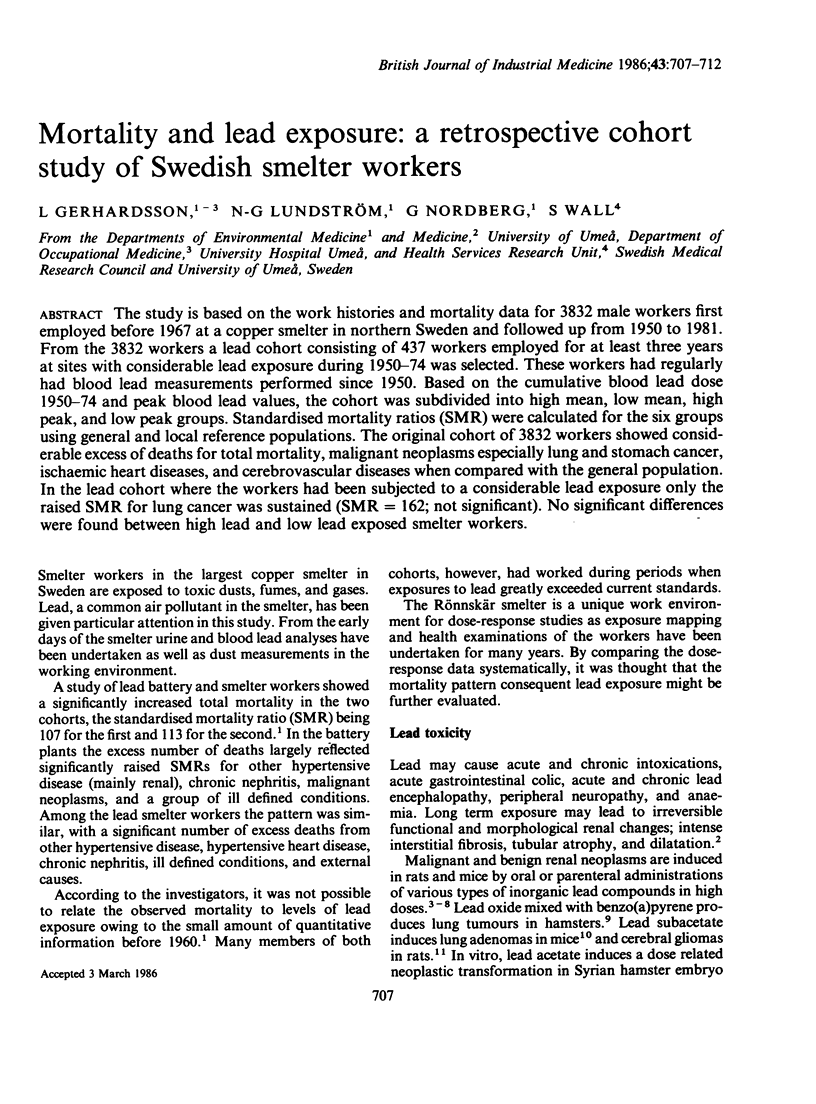
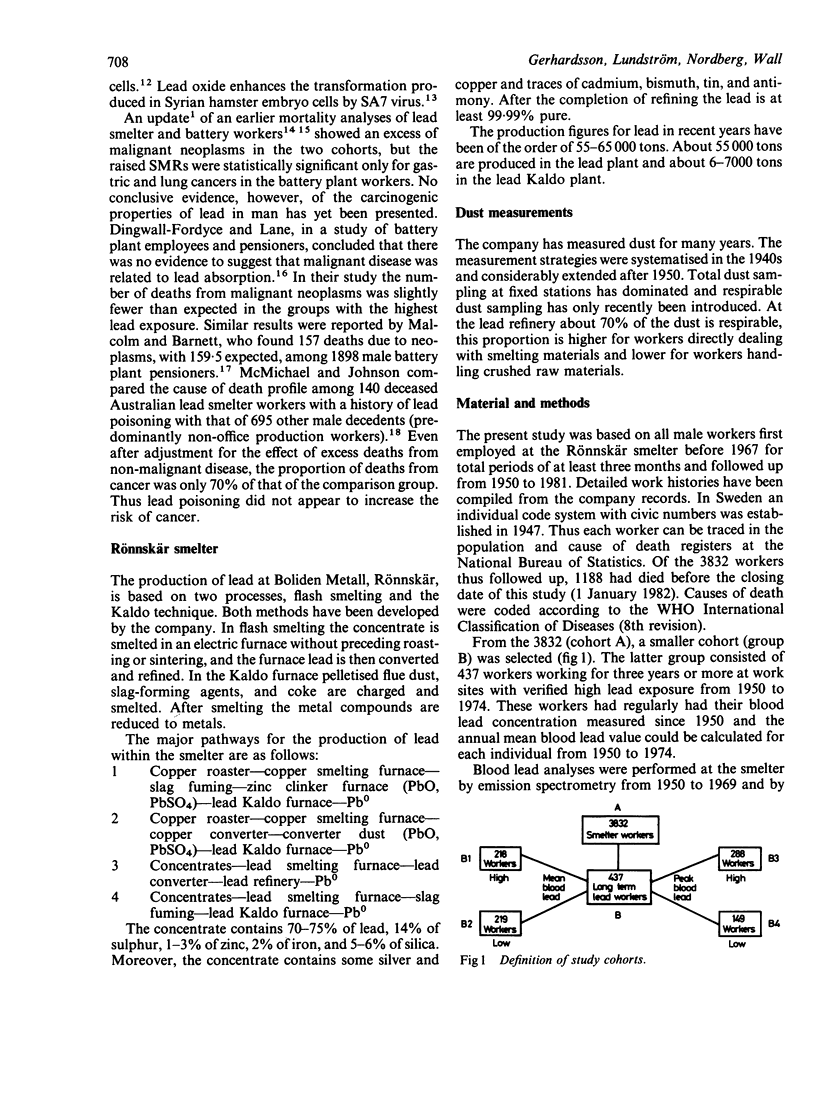
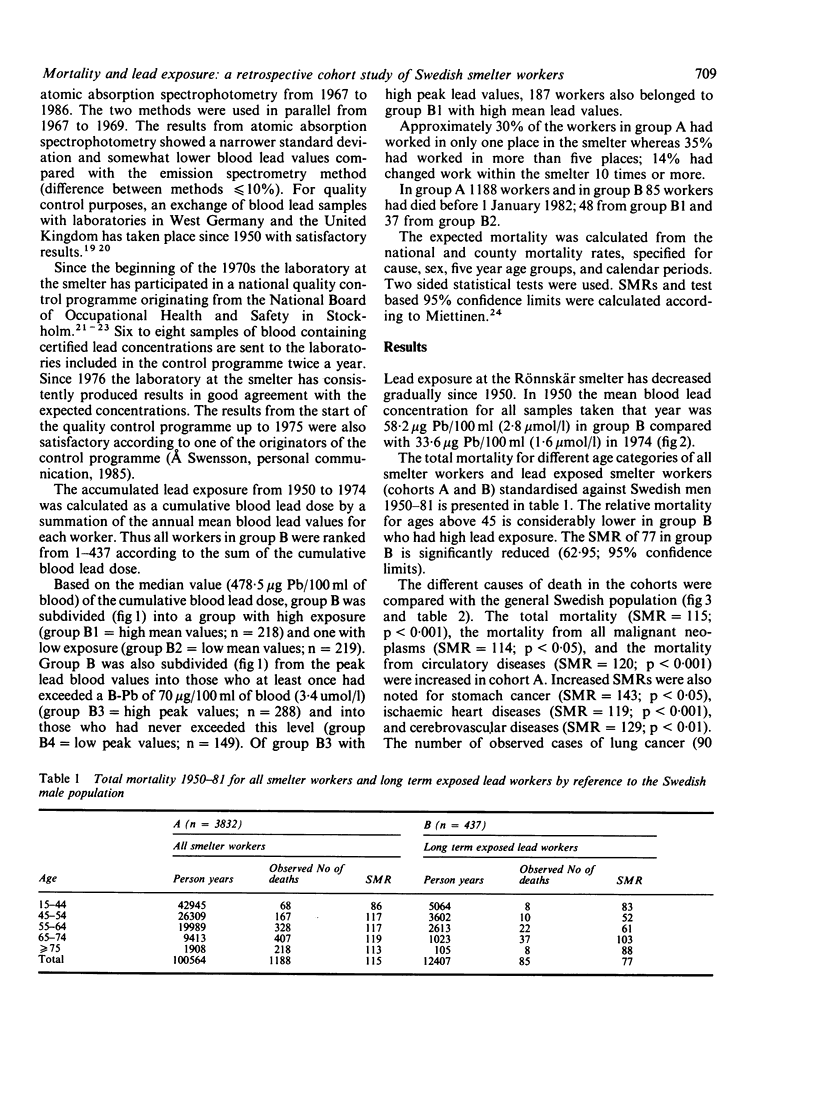
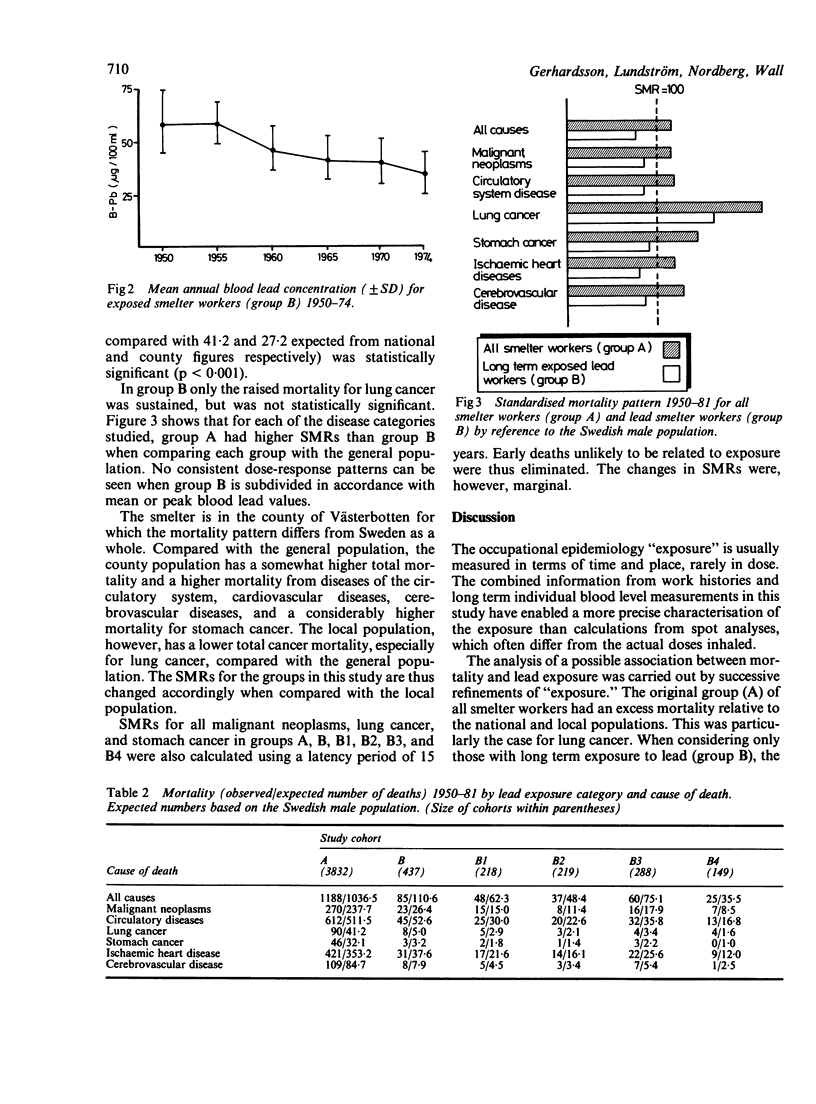
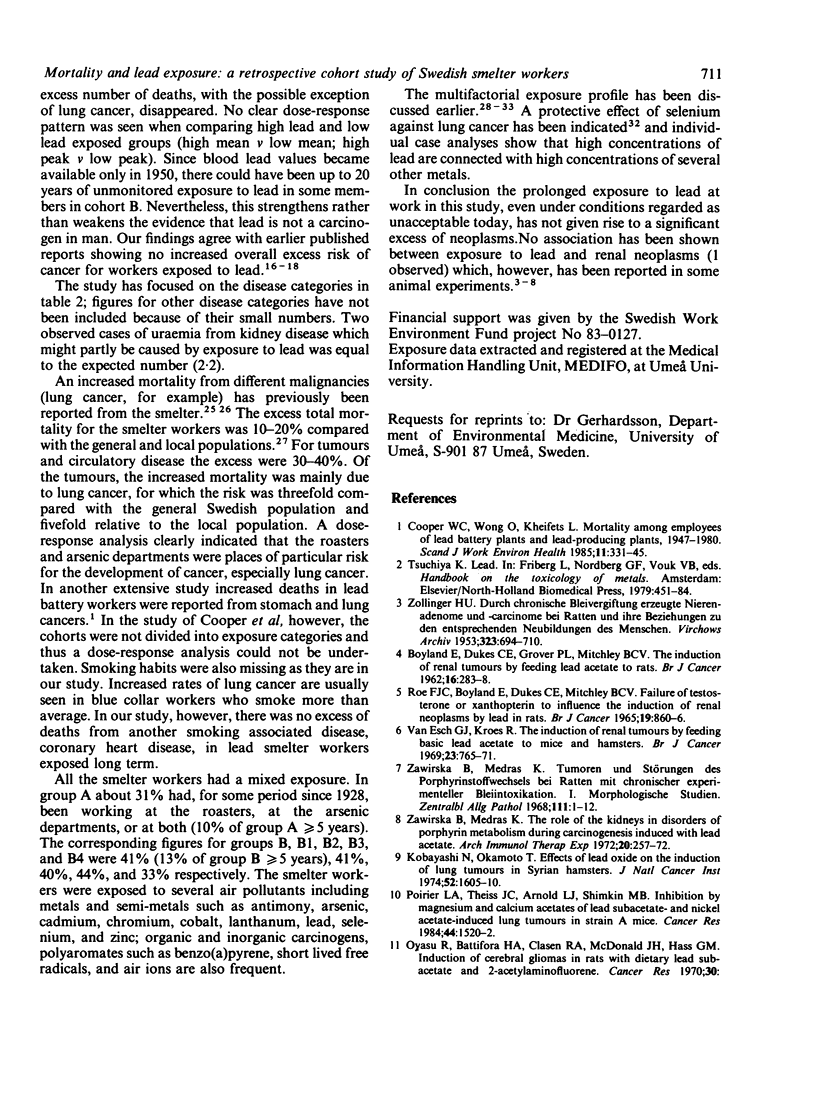
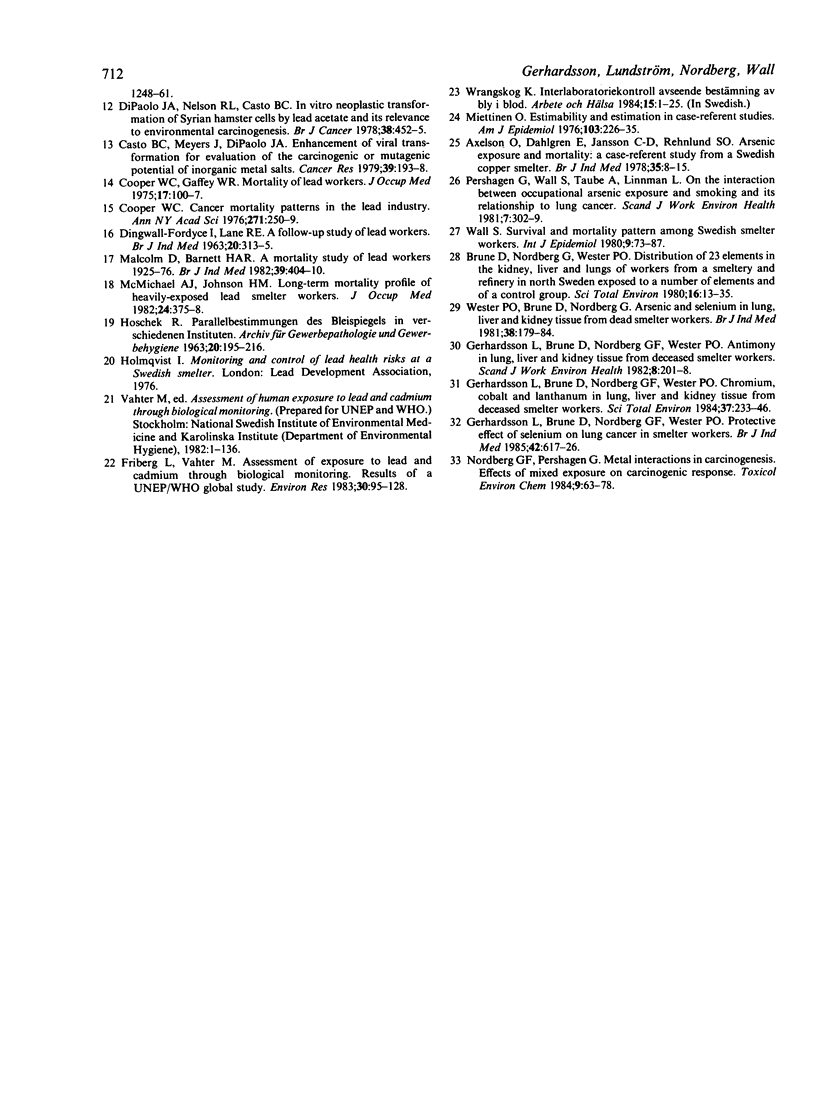
Selected References
These references are in PubMed. This may not be the complete list of references from this article.
- Axelson O., Dahlgren E., Jansson C. D., Rehnlund S. O. Arsenic exposure and mortality: a case-referent study from a Swedish copper smelter. Br J Ind Med. 1978 Feb;35(1):8–15. doi: 10.1136/oem.35.1.8. [DOI] [PMC free article] [PubMed] [Google Scholar]
- BOYLAND E., DUKES C. E., GROVER P. L., MITCHLEY B. C. The induction of renal tumors by feeding lead acetate to rats. Br J Cancer. 1962 Jun;16:283–288. doi: 10.1038/bjc.1962.33. [DOI] [PMC free article] [PubMed] [Google Scholar]
- Brune D., Nordberg G., Wester P. O. Distribution of 23 elements in the kidney, liver and lungs of workers from a smeltery and refinery in North Sweden exposed to a number of elements and of a control group. Sci Total Environ. 1980 Sep;16(1):13–35. doi: 10.1016/0048-9697(80)90100-x. [DOI] [PubMed] [Google Scholar]
- Casto B. C., Meyers J., DiPaolo J. A. Enhancement of viral transformation for evaluation of the carcinogenic or mutagenic potential of inorganic metal salts. Cancer Res. 1979 Jan;39(1):193–198. [PubMed] [Google Scholar]
- Cooper W. C. Cancer mortality patterns in the lead industry. Ann N Y Acad Sci. 1976;271:250–259. doi: 10.1111/j.1749-6632.1976.tb23119.x. [DOI] [PubMed] [Google Scholar]
- Cooper W. C., Gaffey W. R. Mortality of lead workers. J Occup Med. 1975 Feb;17(2):100–107. doi: 10.1097/00043764-197502000-00012. [DOI] [PubMed] [Google Scholar]
- Cooper W. C., Wong O., Kheifets L. Mortality among employees of lead battery plants and lead-producing plants, 1947-1980. Scand J Work Environ Health. 1985 Oct;11(5):331–345. doi: 10.5271/sjweh.2215. [DOI] [PubMed] [Google Scholar]
- DINGWALL-FORDYCE I., LANE R. E. A FOLLOW-UP STUDY OF LEAD WORKERS. Br J Ind Med. 1963 Oct;20:313–315. doi: 10.1136/oem.20.4.313. [DOI] [PMC free article] [PubMed] [Google Scholar]
- Dipaolo J. A., Nelson R. L., Casto B. C. In vitro neoplastic transformation of Syrian hamster cells by lead acetate and its relevance to environmental carcinogenesis. Br J Cancer. 1978 Sep;38(3):452–455. doi: 10.1038/bjc.1978.228. [DOI] [PMC free article] [PubMed] [Google Scholar]
- Friberg L., Vahter M. Assessment of exposure to lead and cadmium through biological monitoring: results of a UNEP/WHO global study. Environ Res. 1983 Feb;30(1):95–128. doi: 10.1016/0013-9351(83)90171-8. [DOI] [PubMed] [Google Scholar]
- Gerhardsson L., Brune D., Nordberg G. F., Wester P. O. Antimony in lung, liver and kidney tissue from deceased smelter workers. Scand J Work Environ Health. 1982 Sep;8(3):201–208. doi: 10.5271/sjweh.2475. [DOI] [PubMed] [Google Scholar]
- Gerhardsson L., Brune D., Nordberg I. G., Wester P. O. Protective effect of selenium on lung cancer in smelter workers. Br J Ind Med. 1985 Sep;42(9):617–626. doi: 10.1136/oem.42.9.617. [DOI] [PMC free article] [PubMed] [Google Scholar]
- Gerhardsson L., Wester P. O., Nordberg G. F., Brune D. Chromium, cobalt and lanthanum in lung, liver and kidney tissue from deceased smelter workers. Sci Total Environ. 1984 Aug 1;37(2-3):233–246. doi: 10.1016/0048-9697(84)90099-8. [DOI] [PubMed] [Google Scholar]
- Kobayashi N., Okamoto T. Effects of lead oxide on the induction of lung tumors in Syrian hamsters. J Natl Cancer Inst. 1974 May;52(5):1605–1610. doi: 10.1093/jnci/52.5.1605. [DOI] [PubMed] [Google Scholar]
- Malcolm D., Barnett H. A. A mortality study of lead workers 1925-76. Br J Ind Med. 1982 Nov;39(4):404–410. doi: 10.1136/oem.39.4.404. [DOI] [PMC free article] [PubMed] [Google Scholar]
- McMichael A. J., Johnson H. M. Long-term mortality profile of heavily-exposed lead smelter workers. J Occup Med. 1982 May;24(5):375–378. doi: 10.1097/00043764-198205000-00008. [DOI] [PubMed] [Google Scholar]
- Miettinen O. Estimability and estimation in case-referent studies. Am J Epidemiol. 1976 Feb;103(2):226–235. doi: 10.1093/oxfordjournals.aje.a112220. [DOI] [PubMed] [Google Scholar]
- Poirier L. A., Theiss J. C., Arnold L. J., Shimkin M. B. Inhibition by magnesium and calcium acetates of lead subacetate- and nickel acetate-induced lung tumors in strain A mice. Cancer Res. 1984 Apr;44(4):1520–1522. [PubMed] [Google Scholar]
- Roe F. J., Boyland E., Dukes C. E., Mitchley B. C. Failure of testosterone or xanthopterin to influence the induction of renal neoplasms by lead in rats. Br J Cancer. 1965 Dec;19(4):860–866. doi: 10.1038/bjc.1965.99. [DOI] [PMC free article] [PubMed] [Google Scholar]
- Van Esch G. J., Kroes R. The induction of renal tumours by feeding basic lead acetate to mice and hamsters. Br J Cancer. 1969 Dec;23(4):765–771. doi: 10.1038/bjc.1969.95. [DOI] [PMC free article] [PubMed] [Google Scholar]
- Wall S. Survival and mortality pattern among Swedish smelter workers. Int J Epidemiol. 1980 Mar;9(1):73–87. doi: 10.1093/ije/9.1.73. [DOI] [PubMed] [Google Scholar]
- Wester P. O., Brune D., Nordberg G. Arsenic and selenium in lung, liver, and kidney tissue from dead smelter workers. Br J Ind Med. 1981 May;38(2):179–184. doi: 10.1136/oem.38.2.179. [DOI] [PMC free article] [PubMed] [Google Scholar]
- ZOLLINGER H. U. Durch chronische Bleivergiftung erzeugte Nierenadenome und -carcinome bei Ratten und ihre Beziehungen zu den entsprechenden Neubildungen des Menschen. Virchows Arch Pathol Anat Physiol Klin Med. 1953;323(6):694–710. doi: 10.1007/BF00956266. [DOI] [PubMed] [Google Scholar]
- Zawirska B., Medraś K. The role of the kidneys in disorders of porphyrin metabolism during carcinogenesis induced with lead acetate. Arch Immunol Ther Exp (Warsz) 1972;20(2):257–272. [PubMed] [Google Scholar]
- Zawirska B., Medraś K. Tumoren und Störungen des Porphyrinstoffwechsels bei Ratten mit chronischer experimenteller Bleiintoxikation. I. Morphologische Studien. Zentralbl Allg Pathol. 1968;111(1):1–12. [PubMed] [Google Scholar]


